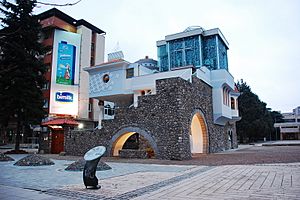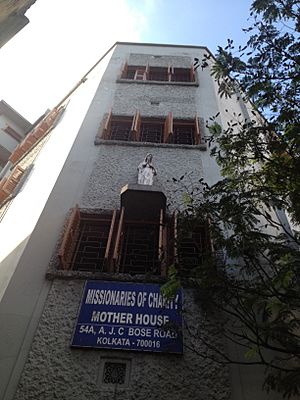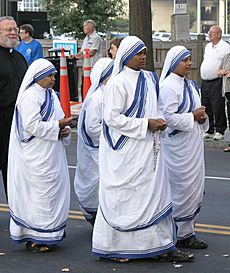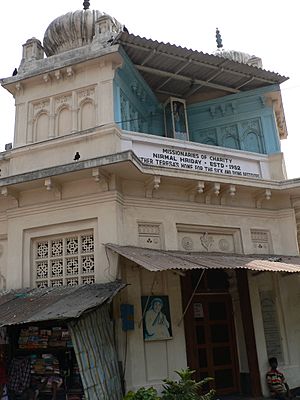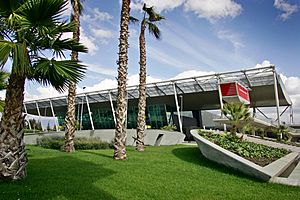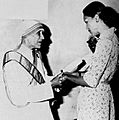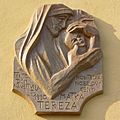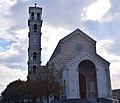Mother Teresa facts for kids
Quick facts for kids SaintTeresa of Calcutta MC |
|
|---|---|
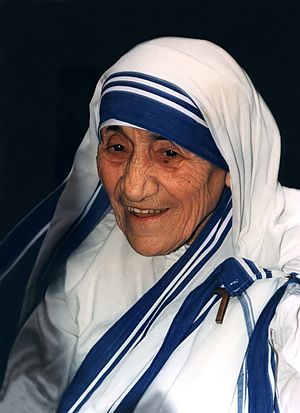
Mother Teresa in 1995
|
|
| Virgin | |
| Born | Anjezë Gonxhe Bojaxhiu 26 August 1910 Üsküp, Kosovo Vilayet, Ottoman Empire (present-day Skopje, North Macedonia) |
| Died | 5 September 1997 (aged 87) Calcutta, West Bengal, India |
| Venerated in | Catholic Church |
| Beatified | 19 October 2003, Saint Peter's Square, Vatican City by Pope John Paul II |
| Canonized | 4 September 2016, Saint Peter's Square, Vatican City by Pope Francis |
| Major shrine | Mother House of the Missionaries of Charity, Calcutta, West Bengal, India |
| Feast | 5 September |
| Patronage |
|
Mary Teresa Bojaxhiu (born Anjezë Gonxhe Bojaxhiu, 26 August 1910 – 5 September 1997), known as Mother Teresa, was an Albanian Catholic nun. She founded the Missionaries of Charity, a group dedicated to helping the poor.
Born in Skopje, which was then part of the Ottoman Empire, she moved to Ireland at 18. Later, she went to India, where she lived most of her life. On 4 September 2016, the Catholic Church made her a saint, calling her Saint Teresa of Calcutta. Her feast day is 5 September, the anniversary of her death.
Mother Teresa's group, the Missionaries of Charity, grew to have over 4,500 nuns by 2012. They work in 133 countries. They run homes for people who are very sick or dying, like those with HIV/AIDS, leprosy, and tuberculosis. They also provide food, medical care, and support for children and families. Members take special promises to live simply and serve "the poorest of the poor" with all their heart.
Mother Teresa received many awards for her work. These include the 1962 Ramon Magsaysay Peace Prize and the 1979 Nobel Peace Prize.
Contents
Early Life and Calling
Mother Teresa's birth name was Anjezë Gonxhe Bojaxhiu. "Gonxhe" means "rosebud" or "little flower" in Albanian. She was born on 26 August 1910 in Skopje, which is now the capital of North Macedonia. She was baptized the day after she was born.
She was the youngest child of Nikollë and Dranafile Bojaxhiu. Her father, who was involved in local politics, died in 1919 when she was eight years old.
From a young age, Anjezë loved hearing stories about missionaries helping people in Bengal. By age 12, she felt strongly that she should dedicate her life to religious service.
Life in India and Becoming a Nun
In 1928, at 18, Anjezë left home to join the Sisters of Loreto in Ireland. She went there to learn English so she could become a missionary in India. She never saw her mother or sister again after leaving.
She arrived in India in 1929. She began her training in Darjeeling, where she learned Bengali and taught at St. Teresa's School. On 24 May 1931, she took her first religious vows. She chose the name Teresa after Thérèse of Lisieux, a saint who was a patron of missionaries.
Teresa took her final vows on 14 May 1937. She was a teacher at the Loreto convent school in Calcutta for nearly 20 years. She became the headmistress in 1944. Even though she enjoyed teaching, she was very worried by the extreme poverty around her in Calcutta. The Bengal famine of 1943 caused much suffering and death in the city.
In 1946, while traveling by train, Mother Teresa felt a special call to serve the poorest people in India. She asked for and received permission to leave the school. In 1950, she started the Missionaries of Charity. She chose a simple white sari with two blue borders as their uniform.
Starting the Missionaries of Charity
On 10 September 1946, Mother Teresa felt a deeper "call within the call" to help the poor. This happened during a train journey to Darjeeling.
She began her missionary work with the poor in 1948. She changed from her traditional nun's habit to a simple white cotton sari with a blue border. Mother Teresa became an Indian citizen. She spent several months learning basic medical skills. Then, she went into the slums to help. She opened a school in Motijhil, Calcutta, before focusing on caring for the sick and hungry. By early 1949, other young women joined her, and she started a new religious group to help the "poorest among the poor."
Her work quickly got attention from Indian leaders, including the prime minister. Mother Teresa wrote that her first year was very hard. She had no money and had to beg for food and supplies. She sometimes felt lonely and wanted to return to the comfort of convent life.
On 7 October 1950, the Vatican officially approved the Missionaries of Charity. Mother Teresa said their goal was to care for "the hungry, the naked, the homeless, the crippled, the blind, the lepers, all those people who feel unwanted, unloved, uncared for."
In 1952, Mother Teresa opened her first hospice with help from Calcutta officials. She turned an old Hindu temple into the Kalighat Home for the Dying. It was free for the poor. She renamed it Kalighat, the Home of the Pure Heart (Nirmal Hriday). People brought there received medical care and could die with dignity according to their own faith.
She also opened a hospice for people with leprosy, called Shanti Nagar (City of Peace). The Missionaries of Charity set up clinics for leprosy patients across Calcutta, giving them medicine, dressings, and food. They also took in more and more homeless children. In 1955, Mother Teresa opened Nirmala Shishu Bhavan, a home for orphans and homeless youth.
The group grew, getting more members and donations. By the 1960s, they had opened hospices, orphanages, and leper houses all over India. Mother Teresa then expanded the group internationally. In 1965, they opened a house in Venezuela. More houses followed in Italy, Tanzania, and Austria in 1968. During the 1970s, they opened homes in the United States and many other countries in Asia, Africa, and Europe.
Other branches of the Missionaries of Charity were also started. The Missionaries of Charity Brothers began in 1963. A branch for contemplative sisters (who focus on prayer) followed in 1976. Many lay people (non-nuns or priests) also joined as Co-Workers. In 1984, Mother Teresa helped found the Missionaries of Charity Fathers for priests.
By 1997, the group had grown from 13 members in Calcutta to over 4,000 sisters worldwide. They ran orphanages, AIDS hospices, and charity centers. They cared for refugees, the blind, disabled, elderly, and victims of disasters. By 2007, there were about 450 brothers and 5,000 sisters. They operated 600 missions, schools, and shelters in 120 countries.
Global Humanitarian Work
Mother Teresa sometimes traveled outside India to help people. In 1971, she visited Troubles-era Belfast with four of her sisters.
In 1982, during the Siege of Beirut, Mother Teresa helped rescue 37 children. They were trapped in a hospital in a war zone. She arranged a temporary cease-fire between the Israeli army and Palestinian fighters. With Red Cross workers, she went through the war zone to get the children out.
Mother Teresa also traveled to help the hungry in Ethiopia. She visited radiation victims at Chernobyl and earthquake victims in Armenia. In 1991, she returned to Albania for the first time. There, she opened a Missionaries of Charity Brothers home in Tirana.
By 1996, the Missionaries of Charity ran 517 missions in over 100 countries. The number of sisters grew from 12 to thousands. They served the "poorest of the poor" in 450 centers worldwide. The first Missionaries of Charity home in the United States opened in the South Bronx area of New York City. By 1984, the group had 19 centers across the country.
Later Years and Passing
Mother Teresa had a heart attack in Rome in 1983 while visiting Pope John Paul II. After a second attack in 1989, she received a pacemaker. In 1991, she had more heart problems after getting pneumonia in Mexico. Mother Teresa offered to step down as head of the Missionaries of Charity. However, the sisters voted for her to stay, and she agreed.
In April 1996, Mother Teresa fell and broke her collarbone. Four months later, she had malaria and heart failure. Although she had heart surgery, her health was clearly getting worse.
On 13 March 1997, Mother Teresa resigned as head of the Missionaries of Charity. She passed away on 5 September 1997.
Mother Teresa's body lay in an open casket in St Thomas, Calcutta, for a week before her funeral. The Indian government gave her a state funeral. This was to thank her for her service to the poor people of all religions in the country.
Interesting Facts About Mother Teresa
- Mother Teresa considered 27 August, the day she was baptized, her "true birthday."
- She could speak five languages: Bengali, Albanian, Serbian, English, and Hindi.
- Many people admired Mother Teresa for her charity work. However, some criticized her views and the conditions in her homes for the dying.
- Her official biography, written by Navin Chawla, was published in 1992. Many other books and films have been made about her.
- On 6 September 2017, Mother Teresa and Saint Francis Xavier were named special protectors of the Roman Catholic Archdiocese of Calcutta.
- Museums have honored her, and many churches are named after her.
- Buildings, roads, and even Albania's international airport are named after her.
- Mother Teresa Day (Dita e Nënë Terezës), on 19 October, is a public holiday in Albania.
- In 2012, Mother Teresa was ranked number 5 in Outlook India's poll of the Greatest Indian.
- Indian Railways introduced the "Mother Express," a new train named after Mother Teresa, on 26 August 2010. This was to celebrate 100 years since her birth.
- Sacred Heart University in Fairfield, Connecticut, has a residence hall named Teresa of Calcutta Hall.
- Since 5 September 2013, the anniversary of her death has been named the International Day of Charity by the United Nations General Assembly.
Mother Teresa's Inspiring Quotes
- “If you judge people, you have no time to love them.”
- “Not all of us can do great things. But we can do small things with great love.”
- “Peace begins with a smile.”
- “The most terrible poverty is loneliness, and the feeling of being unloved.”
- “Kind words can be short and easy to speak, but their echoes are truly endless.”
- “It's not how much we give but how much love we put into giving.”
- “God doesn't require us to succeed, he only requires that you try.”
Becoming a Saint: Miracles and Canonization
After Mother Teresa's death in 1997, the Holy See began the process to make her a saint. This process is called beatification and then canonization.
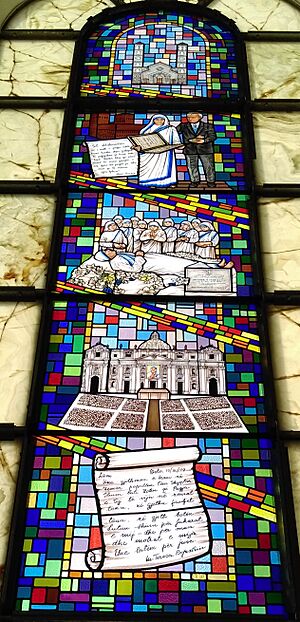
To become a saint, the Catholic Church usually requires proof of a miracle that happened because the person prayed for it after their death. In 2002, the Vatican recognized the healing of Monica Besra, an Indian woman, as a miracle. She had a tumor in her abdomen that disappeared after she placed a locket with Mother Teresa's picture on it. Monica said a beam of light came from the picture and cured her. However, her husband and some medical staff said she was cured by regular medical treatment.
During the process of making Mother Teresa a saint, the Vatican looked at all criticisms of her life and work. They found no reason to stop her from becoming a saint. Mother Teresa was beatified on 19 October 2003. After this, Catholics called her "Blessed Teresa."
On 17 December 2015, the Vatican confirmed a second miracle linked to Mother Teresa. This was the healing of a Brazilian man with several brain tumors in 2008. Pope Francis officially recognized this miracle.
Pope Francis made her a saint at a ceremony on 4 September 2016. This took place in St. Peter's Square in Vatican City. Tens of thousands of people watched, including leaders from 15 countries and 1,500 homeless people from Italy. The ceremony was shown live on TV and online. Skopje, Mother Teresa's hometown, celebrated her sainthood for a whole week. In India, the Missionaries of Charity held a special Mass in Calcutta.
Images for kids
-
President Ronald Reagan presents Mother Teresa with the Presidential Medal of Freedom at a White House ceremony as First Lady Nancy Reagan looks on, 20 June 1985.
-
Plaque dedicated to Mother Teresa in Wenceslas Square, Olomouc, Czech Republic
-
Cathedral of Saint Mother Teresa, Prishtinë
See also
 In Spanish: Teresa de Calcuta para niños
In Spanish: Teresa de Calcuta para niños
- Abdul Sattar Edhi
- Albanians
- List of Albanians
- List of female Nobel laureates
- The Greatest Indian
- Roman Catholicism in Albania
- Roman Catholicism in Kosovo
- Roman Catholicism in North Macedonia


